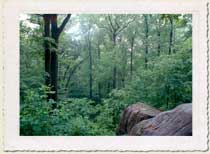
Van Cortlandt Park Preserve
Borough: Bronx
Acres: 573
Habitat Type: Forest, Freshwater Wetland, Meadow
Van Cortlandt Park Preserve, the third largest of the Forever Wild Nature Preserves, comprises over half of the 1,150-acre park. The preserve occupies the northern section of the park, with four distinct areas: the Northwest and Northeast Forests, the Tibbetts Brook/Van Cortlandt Lake, and Vault Hill. Fifteen thousand years ago, the massive glaciers covering New York receded and left behind the characteristic sketch of Van Cortlandt Park—steep ridges, smooth hillsides, and open flats—and exposed its three major rock components: Fordham Gneiss, Inwood Dolomite, and Manhattan Schist. Among the many animals that burrow, nest, feed, and rest in this urban wild, some of the most noteworthy are red fox, which have been seen in the hilly forests, and a small flock of eatern bluebirds (New York’s state bird) which have been glimpsed crossing the Vault Hill meadow.
Fordham Gneiss, one of the oldest rock formations on Earth, characterizes Van Cortlandt’s dramatic cliffs in the Northwest Forest, the largest forest in the preserve (188 acres). This oak-hickory forest grows on rocky heights overlooking valleys dominated by tulip trees (Liriodendron tulipifera) and century-old oaks. Ground layer wildflowers are extraordinarily diverse in the Northwest Forest. There is bloodroot (Sanguinaria canadensis), trout lily (Erythronium americanum), rattlesnake root (Prenantles racemosa), and many asters, including heart-leafed aster (Aster divaricatus). The forest contains one of the highest concentrations of rare plants in the city, including giant yellow hyssop (Agastache neptoides), golden seal (Hydrastis canadensis), and wingstem (Verbesina alternifolia). The Northeast Forest contains low-lying, moisture-retaining land ideal for sweetgum (Liquidambar styraciflua), red maple (Acer rubrum), and pin oak (Quercus palustris). Tibbett’s Brook cuts through soft Inwood marble on its way from Westchester to Spuyten Duyvil, and feeds the man made Van Cortlandt Lake. Tibbetts Brook and its associated wetlands are a must-see for bird watchers, where predators like barred owls (Strix varia) and red-tailed hawks (Buteo jamaicensis) hunt, and wood ducks (Aix sponsa), known for jumping from their high nests soon after hatching, have been sited. Meadows are not typically found within the City, Vault Hill boasts one of the prettiest and most varied, composed of switchgrass (Panicum virgatum), little bluestem (Schizachyrium scoparium), and such wildflowers as birdsfoot trefoil (Lotus corniculatus), ironweed (Veronia noveboracensis), and sweet white clover (Melilotus alba). This is one of the few places in the City where the eastern bluebird (the New York State bird) can be seen.
To see all of the park’s natural assets walk along one of its many nature trails. The Cass Gallagher (2 miles) serves the Northwest Forest. A narrow belt of lowland swamp forest still survives along the Kieran Trail (1.7 miles) around the open water, where pin oak (Quercus palustris) and red maple (Acer rubrum) grow above Solomon’s seal (Polygonatum biflorum), Virginia creeper (Parthenocissus quinquefolia), marsh fern (Thelypteris palustris), and sensitive fern (Onoclea sensibilis). The John Kieran (1.7 miles) journeys through the parks’ lake area and freshwater wetlands, and forms a loop with the Parade Ground, the John Muir (1.5 miles) serves the Northwest and is Van Cortlandt’s only east-west path, traversing the steep terrain at the park’s center. The Putnam and Old Croton Aqueduct Trail are the major north-south trails. The Aqueduct Trail in particular provides a wonderful woodland walkway. In this rich forest, stands of black walnut (Juglans nigra), American sycamore (Platanus occidentalis), and American elm (Ulmus americana) are present, along with sugar maple (Acer saccharum), which is native to New England and rarely seen in these parts.
Directions
By Car: The Major Deegan Expressway has two park exits: Van Cortlandt Park South, which serves the south and west portions of the park, and East 233rd Street, which serves the north and east. The Henry Hudson Parkway’s Broadway exits also serve the park. Mosholu Parkway links Van Cortlandt Park with the Bronx River and Pelham parkways. Broadway goes right by the Parade Ground. Use the highways to get to it, though it’s usually very busy. The same can be said of Jerome Avenue on the park’s eastern border. Bus:
Public Transit The Bx9 travels along Broadway on the western edge of Van Cortlandt Park. The BxM3, an express line serving Manhattan, also offers access to the park’s western border. The park’s east side is served by the Bx16 and the Bx34. Westchester bus lines Nos. 1,2,3,4,20, and 21 also serve the park.
By Subway: The northern terminus of the 1/9 at W. 242nd Street is near the Parade Ground. No. 4 last stop at Woodlawn serves the park’s southeastern area.
